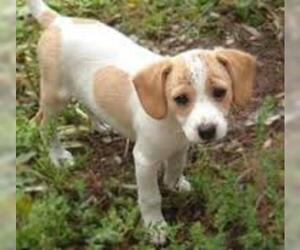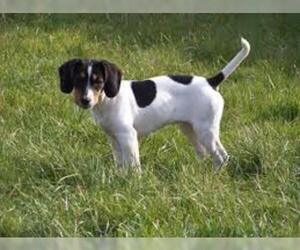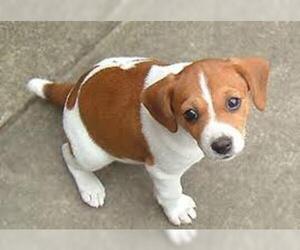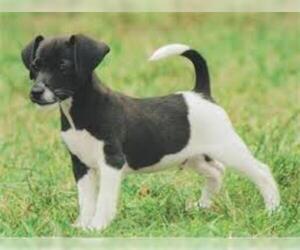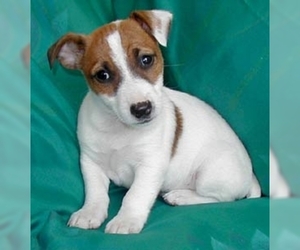All about Jack-A-Bee dog breed
A.K.A. :Jackabee, Jack-A-Bee Terrier
Jack-A-Bee is a mix of
Size
Grooming requirements
Exercise requirements
Good with other dogs
Watchdog ability
Energetic
Training requirements
Playful
Affectionate
Good with other pets
Good with children
Good with strangers
Winter
Summer
Healthiness
Protective
Life Span
| Mixed Breeds | Member |
| Breeds A - Z | J |
| Breeds by Group | Terrier |
| Breeds by Trait | Good With Kids High Stamina Dog Breeds Smartest Dog Breeds |
| Overview: | The Jack-A-Bee is a captivating crossbreed, a delightful blend of the ever-popular Beagle and the spirited Jack Russell Terrier. Originating from designer breed efforts to combine the best traits of both parents, these charming canines typically boast a compact yet muscular build, often inheriting the Beagle's distinct tri-color or bi-color coat patterns alongside the Jack Russell's expressive eyes and alert ears. Temperament-wise, they are a lively mix: expect the Beagle’s friendly, curious nature coupled with the Jack Russell’s energetic, intelligent, and sometimes mischievous streak. While adaptable, their energy levels make them better suited for active families or individuals who can provide ample exercise and mental stimulation; apartment living is possible with dedicated outdoor time. Potential health concerns may include those common to both parent breeds, such as hip and elbow dysplasia, eye conditions, and certain ear infections, making regular veterinary check-ups essential for a long, happy life. |
F.A.Q.
All You Need to Know About the "Jack-A-Bee" Breed (parent breeds: "Beagle" × "Jack Russell Terrier")
The Jack-A-Bee is a charming and energetic hybrid, combining the friendly nature of the Beagle with the spirited intelligence of the Jack Russell Terrier. Originating from these two popular breeds, the Jack-A-Bee typically inherits a playful and affectionate temperament, making them wonderful family pets. Physically, they are medium-sized dogs, often with the Beagle's characteristic floppy ears and a build that's more compact than a purebred Beagle, usually weighing between 15-30 pounds. Their coats can vary, but are generally short and easy to maintain.Jack-A-Bees thrive on activity, requiring moderate daily exercise to keep them happy and prevent boredom. This includes walks, playtime, and mental stimulation. While adaptable, they are generally not ideal for small apartment living unless their exercise needs are consistently met. Their intelligence means they are trainable, but can also exhibit a stubborn streak, so consistent positive reinforcement is key. Grooming is minimal, requiring occasional brushing. Potential owners should be aware of common health concerns found in their parent breeds, such as ear infections, hip dysplasia, and certain eye conditions. Overall, the Jack-A-Bee is a loyal, spirited, and loving companion for active individuals or families.The average weight for a Jack-A-Bee is typically between 15 to 30 pounds. This healthy weight for Jack-A-Bee can vary, with males often being slightly heavier than females. Generally, female Jack-A-Bees range from 15-25 pounds, while males can reach 20-30 pounds. This makes them a medium-small sized dog, a good choice for various living situations.
Jack-A-Bee Height: What to Expect for This Charming Hybrid
When considering a Jack-A-Bee, one of the most common questions is about their size. So, how tall is a Jack-A-Bee? As a delightful cross between a Beagle and a Jack Russell Terrier, the Jack-A-Bee typically falls into the small to medium-sized dog category. Their average height, measured at the shoulder, generally ranges from 12 to 16 inches.This range provides a good indication of the typical adult height. It's important to remember that, like all hybrid breeds, there can be some variation. Individual genetics play a significant role, meaning some Jack-A-Bees might lean more towards the Beagle's slightly larger stature, while others might take after the more compact Jack Russell. While there isn't a stark difference, you might find that male Jack-A-Bees tend to be at the higher end of this range, while females might be a bit shorter or daintier. Factors like nutrition during growth and overall health can also subtly influence their final adult height.Ultimately, a Jack-A-Bee's height makes them a manageable and versatile companion, fitting comfortably into various living situations, from apartments to homes with yards. When looking for your new furry friend, understanding their expected size can help you prepare for their needs and ensure a perfect match!Jack-A-Bee Colors: A Guide to Their Diverse CoatsThe Jack-A-Bee (Beagle × Jack Russell Terrier mix) exhibits a delightful range of Jack-A-Bee colors, inherited from its parent breeds. When considering Jack-A-Bee coat types, you'll primarily find combinations of white, black, and tan.Common and Accepted Jack-A-Bee Colors:The most frequently seen and generally accepted Jack-A-Bee colors include:* Tri-color: A classic combination of white, black, and tan/brown, often resembling a Beagle's markings. This is a highly desired Jack-A-Bee color.* Black and White: A striking two-tone coat.* Tan and White (or Lemon and White): Varying shades of tan or lemon with white markings.* Black and Tan: Solid black with tan points, similar to some Jack Russell Terriers.* Solid White: Though less common, some Jack-A-Bees can be primarily white with minimal markings.* Brown and White: Shades of brown paired with white.While the Jack-A-Bee is a hybrid, and thus not officially recognized by major kennel clubs like the AKC, understanding the accepted colors of its parent breeds provides insight. The AKC recognizes Beagle colors such as tri-color, black and tan, lemon and white, and red and white. For the Jack Russell Terrier, the AKC recognizes white with black, tan, or brown markings. Therefore, the common Jack-A-Bee colors listed above align with the accepted variations of their purebred lineage. Potential adopters will find these Jack-A-Bee colors widely available.Rare and Exotic Jack-A-Bee Variations:While not typical, some rare Jack-A-Bee variations can occasionally appear due to recessive genes or less common genetics in the parent lines. These exotic Jack-A-Bee colors are not recognized by kennel clubs for either parent breed and are much less frequent, often impacting pricing.* Brindle: Stripes or streaks of different colors, though extremely uncommon in Jack-A-Bees.* Fawn: A light, yellowish-tan color.* Cream: A very light, off-white hue.* Blue (Dilute Black): A grayish or slate color, resulting from a dilute black gene. This is a very rare Jack-A-Bee coat type.* Chocolate (Dilute Brown): A lighter, often milky brown color, also resulting from a dilute gene.* Merle: A distinctive pattern with splotches of darker color on a lighter background. Merle is not naturally occurring in Beagles or Jack Russell Terriers, and if seen, it suggests the presence of merle in a more distant ancestor or an intentional cross with another breed. This is an extremely rare Jack-A-Bee variation and may be indicative of other breed influences.* Lilac (Isabella): A very rare dilute of chocolate that appears grayish-pink. This is exceptionally rare and unlikely to be found in a pure Jack-A-Bee lineage.It's important to note that if you encounter a Jack-A-Bee advertised with merle, blue, or lilac colors, it's advisable to inquire about the lineage as these exotic Jack-A-Bee colors are not standard and may indicate other breeds in the mix. These rare coat types might command a higher price due to their uniqueness, but buyers should be aware of their genetic origins. For most potential buyers, the traditional Jack-A-Bee colors will offer plenty of charming choices.
The Jack-A-Bee personality blends the best of both parent breeds. Expect a friendly, loyal, and energetic companion. They are highly sociable and thrive on human interaction, making them excellent family pets. Their temperament of Jack-A-Bee is generally affectionate and playful, often displaying a charming curiosity. With proper training and socialization, they can be good with children, though their high energy means supervision is always a good idea. Regarding other pets, they can coexist well, especially if raised together, but their Terrier instincts might lead to chasing smaller animals. While intelligent and adaptable, their energy levels mean they are not ideally suited for apartment living unless given significant daily exercise. They are bright, eager to please, and respond well to positive reinforcement.
The Jack-A-Bee temperament blends the best of both parent breeds, resulting in a lively and affectionate companion dog. They are typically very friendly and sociable, thriving on interaction with their human family. Expect a loyal and devoted companion who enjoys being at the center of attention.While intelligent, the Jack-A-Bee can inherit a streak of stubbornness from both the Beagle and Jack Russell Terrier, making consistent and positive training essential. They are generally good with children, especially if raised with them, though their energetic nature might be a bit much for very young toddlers. Proper socialization is key for their behavior with other pets; they can get along well, but their prey drive, inherited from the Jack Russell, might surface with smaller, non-canine animals.Regarding adaptability to apartment living, the Jack-A-Bee can adjust if they receive ample daily exercise and mental stimulation. They are not content to be couch potatoes and require regular walks, playtime, and engaging activities to prevent boredom and destructive behaviors. They are not overly sensitive but do respond best to positive reinforcement. Overall, the Jack-A-Bee is an energetic, loving, and intelligent dog perfect for active families looking for a charismatic and devoted companion.
Jack-A-Bee Care: Daily Maintenance & Health TipsCaring for a Jack-A-Bee (Beagle × Jack Russell Terrier mix) involves a balanced approach to ensure a happy, healthy companion.Grooming Needs: Your Jack-A-Bee will require moderate grooming. Expect regular brushing 2-3 times a week to manage shedding, which can vary depending on coat type (short Beagle-like to wiry Terrier-like). Occasional baths are needed to keep their coat clean, especially if they enjoy outdoor adventures. Trim nails every 3-4 weeks to prevent overgrowth.Exercise Limitations: While the Jack-A-Bee isn't typically a "low-energy dog breed," their exercise requirements are moderate. They thrive on daily walks (30-60 minutes), playtime in a secure yard, and mental stimulation. Avoid over-exercising in extreme temperatures. They are not brachycephalic, so climate sensitivity due to respiratory issues is generally not a concern, but always provide shade and water in warm weather.Dietary Considerations: Feed a high-quality, age-appropriate dog food. Monitor their weight closely as both parent breeds can be prone to obesity. Divide daily food into two meals to aid digestion and prevent bloat. Consult your vet for specific dietary recommendations.Wrinkle and Ear Cleaning: Neither parent breed typically has significant wrinkles, so wrinkle cleaning is usually not necessary. However, their ears (which can be floppy like a Beagle or semi-erect like a Jack Russell) require regular checking and cleaning. Clean ears weekly with a vet-approved solution to prevent ear infections, especially if they spend time outdoors or swimming.Common Health Concerns: Be aware of potential health issues. Skin issues can arise, so monitor for redness, itching, or rashes. Dental care is crucial; regular brushing and professional cleanings are recommended to prevent gum disease. Weight management is paramount to prevent joint problems and other health complications. Other potential concerns include patellar luxation, eye conditions, and hypothyroidism, inherited from parent breeds. Regular vet check-ups are essential for early detection and preventative care.How to care for a Jack-A-Bee effectively means providing consistent training, socialization, and a loving home environment.
The Jack-A-Bee activity level is moderately high, balancing the Beagle's endurance with the Jack Russell's zest. They are an energetic breed that thrives on regular stimulation.
Typical Energy Levels: Jack-A-Bees have a good amount of energy and are generally alert and playful. They enjoy short bursts of high-intensity activity, followed by periods of rest and relaxation. They are not perpetually "on the go" but require consistent engagement.Daily Exercise Needs: Plan for at least 45-60 minutes of dedicated exercise daily. This should include walks, runs, or active playtime in a secure yard. Mental stimulation is equally important to prevent boredom, so incorporate puzzle toys or training sessions.Playtime Preferences: They love to chase, fetch, and explore. Their terrier parentage gives them a strong prey drive, so secure off-leash areas are crucial. Interactive games with their human companions are a favorite, as they crave attention and engagement.Brachycephalic Limitations: It's important to note that due to the Beagle's influence, some Jack-A-Bees may exhibit a somewhat brachycephalic (short-nosed) anatomy. This can limit their ability to tolerate strenuous exercise, especially in hot or humid weather. Be mindful of their breathing and watch for signs of overheating. Avoid overexertion during peak temperatures. They balance intense short bursts of energy with longer periods of rest, making them adaptable but requiring owner awareness.Suitability for Families: Jack-A-Bees are suitable for active families who enjoy outdoor activities and are committed to providing daily exercise and mental stimulation. They are generally not ideal for low-energy households unless significant effort is made to outsource their exercise needs. Understanding how active are Jack-A-Bee is key to a happy home.Although Jack-A-Bees are not extreme brachycephalic dogs, some may inherit a slightly shortened muzzle from their Beagle side, making them mildly prone to Brachycephalic Obstructive Airway Syndrome (BOAS). Applying brachycephalic dog care strategies—such as avoiding strenuous activity in hot weather, using a harness instead of a collar, and monitoring breathing during exercise—can help reduce respiratory stress. Their compact, athletic build and high energy also contribute to heat sensitivity, so they should always have access to shade, water, and cool resting areas. Additionally, their active nature and Beagle lineage may predispose them to spinal problems such as arthritis or intervertebral disc disease, particularly if they jump frequently from heights or carry excess weight.
Understanding how to keep Jack-A-Bee healthy involves scheduling regular veterinary checkups, early screening for joint, respiratory, and skin conditions, maintaining a balanced diet to prevent obesity, and providing daily exercise to channel their energy safely. Grooming routines should include brushing to reduce shedding, cleaning ears and skin folds, and dental care to prevent oral disease. With attentive care, Jack-A-Bees can enjoy a playful, loyal life of 12–16 years.
Breed Breakdown: What Experts Say About the Jack-A-Bee
I would rate the "Size" trait of the Jack-A-Bee as a 4.The Jack-A-Bee is a small to medium-sized dog, inheriting its compact stature from both the Beagle and the Jack Russell Terrier. They typically stand around 12-16 inches tall and weigh between 15-30 pounds. Their body structure is generally sturdy and athletic, but not bulky. Compared to truly tiny breeds like Chihuahuas (which might be a 1 or 2) or giant breeds like Great Danes (which would be a 9 or 10), the Jack-A-Bee falls squarely into the smaller end of the companion dog spectrum. This makes them a very good candidate for apartment living, as they don't require vast amounts of space. Their manageable size also makes them excellent for travel, easily fitting into pet carriers or car seats without much fuss. For households with space constraints, the Jack-A-Bee's moderate size is a distinct advantage, allowing them to comfortably navigate smaller homes without feeling cramped.
I would rate the grooming requirements of the Jack-A-Bee at a 4.This breed is relatively low-maintenance when it comes to grooming, but not entirely hands-off. Their short, dense coat, inherited from both parent breeds, sheds moderately year-round, requiring weekly brushing to remove loose hair and keep it healthy. While they don't have extensive skin folds needing specialized care, their ears, particularly if they lean more towards the Beagle's floppy type, will need regular checking and cleaning to prevent infections. Nail trimming every 3-4 weeks is essential, as is with most active breeds. Bathing is only needed occasionally, perhaps every 1-2 months or when they get particularly dirty, to maintain coat health without stripping natural oils. Susceptibility to skin issues and allergies is generally low, but can occur as with any mixed breed, and would elevate the grooming needs if present. Overall, they are easy to care for and don't require frequent, specialized grooming compared to many long-haired or brachycephalic companion dogs.
I'd rate the "Exercise Requirements" of the Jack-A-Bee at a 9.This high rating stems directly from its parent breeds. The Jack Russell Terrier is renowned for its boundless energy, an almost insatiable drive that requires significant outlets. They are built for sustained activity, excellent at agility, and thrive on having a "job" to do, whether it's chasing a ball or exploring. While Beagles are less frantic, they are still working dogs with a strong prey drive and excellent stamina, historically used for long hunts. A Jack-A-Bee will inherit a potent combination of these traits, resulting in a dog that is highly energetic and requires a considerable amount of physical and mental stimulation to prevent boredom and destructive behaviors. They are not content with a short walk around the block and will likely become restless and potentially mischievous if their exercise needs are not met. Daily long walks, vigorous playtime, opportunities for running, and engaging in activities like fetch or even some basic agility training would be highly beneficial to keep them healthy, happy, and mentally stimulated. Their athleticism and lack of brachycephalic limitations mean they can easily tolerate and often demand sustained movement. This breed definitely thrives on structured routines that incorporate plenty of vigorous activity.
I'd rate the Jack-A-Bee's watchdog ability at a 7 out of 10.The Jack-A-Bee inherits a strong sense of alertness from both its parent breeds. The Jack Russell Terrier side contributes a highly vigilant and reactive nature, quick to notice and respond to anything out of the ordinary. They possess strong territorial instincts and a healthy suspicion of strangers. The Beagle, while friendly, also contributes to the barking behavior and a keen sense of smell and hearing that makes them aware of their surroundings. This hybrid will likely be very quick to bark at unfamiliar sounds, sights, or people approaching the home, providing excellent early warnings. Their barking is generally persistent and distinct enough to grab attention. While they might not be an aggressive deterrent in the way a dedicated guardian breed would be, their consistent and vocal alerts, combined with their energetic and sometimes bold demeanor, could certainly deter opportunistic intruders seeking a quiet entry. They are very much capable of providing meaningful early warnings in a home environment and are not just passive companions when it comes to home security.
I'd rate the "Good with Other Dogs" trait of the Jack-A-Bee a 6 out of 10.The Jack-A-Bee, inheriting traits from both the Beagle and the Jack Russell Terrier, generally falls in the middle when it comes to dog-to-dog sociability. Beagles are often quite amiable and social with other dogs, tending to thrive in canine company and being less prone to aggression. However, the Jack Russell Terrier brings a different dynamic. While many JRTs can live peacefully with other dogs, they are also known for their strong prey drive, potential for dominance, and high energy, which can sometimes lead to conflict, especially with unfamiliar dogs or those that challenge them. This combination means that a Jack-A-Bee's compatibility with other dogs is highly dependent on early and consistent socialization. They are unlikely to be outright aggressive without provocation, but their terrier heritage means they may not always back down if challenged and their high energy can be overwhelming for more sedate dogs. They can certainly thrive in multi-dog households, especially if raised with other dogs, but careful introductions and ongoing training are crucial to ensure peaceful coexistence, particularly with dogs of varying sizes and energy levels. They may require more supervision than a naturally more docile breed to prevent squabbles or over-exuberant play from escalating.
Rating: 8/10Explanation: The Jack-A-Bee inherits a significant amount of "energetic" from both of its parent breeds. The Jack Russell Terrier, in particular, is renowned for its boundless energy, high prey drive, and need for constant mental and physical stimulation. Beagles, while perhaps a touch more laid-back than JRTs, are still active scent hounds with good stamina and a love for exploring.This crossbreed is naturally active and far from laid-back compared to many other companion dogs. They will likely possess a high activity level, good endurance, and a strong desire to play. They thrive on regular exercise, including walks, runs, and engaging playtime, and will likely enjoy outdoor and athletic activities. Their need for physical stimulation is considerable, and without it, they can become bored and destructive.It's important to note that neither the Beagle nor the Jack Russell Terrier is considered brachycephalic. Therefore, the Jack-A-Bee will not inherit any anatomical features that typically affect stamina and exercise tolerance in the way a brachycephalic breed might. Their respiratory system should be healthy and efficient, allowing them to maintain their high energy levels during activity without undue risk, provided they are otherwise healthy. Their primary limitation on exercise would be individual health, age, and environmental factors like extreme heat, rather than inherent anatomical constraints.
I would rate the training requirements of a Jack-A-Bee a 7 out of 10.While intelligent, the Jack-A-Bee inherits a significant amount of stubbornness and independence from both parent breeds, particularly the Jack Russell Terrier. Their attention spans can be short, especially when something more exciting (like a scent trail) catches their interest. They are responsive to commands but often choose to "think about it" first, making consistency absolutely crucial. Positive reinforcement is highly effective, but it needs to be delivered with enthusiasm and quickly to capture their attention. This breed is not beginner-friendly and requires an experienced handler who can provide firm, consistent, and patient training, along with structured routines to manage their high energy and strong prey drive. Without proper training and socialization, they can develop behavioral issues due to boredom or a perceived lack of leadership.
The Jack-A-Bee rates a 9 out of 10 for playfulness. This breed inherits a potent combination of high energy and curiosity from both its Beagle and Jack Russell Terrier parents. They are naturally spirited and far from laid-back, typically eager to engage in any activity you present. Expect a Jack-A-Bee to be a constant invitation to play, whether it's chasing a ball, wrestling with a squeaky toy, or simply romping around the yard. Their love for games and interaction is profound, often expressed through enthusiastic tail wags, playful nips (gentle ones, of course!), and a persistent nudge for attention. They respond to toys and playtime with remarkable enthusiasm, viewing almost any object as a potential plaything and every moment as an opportunity for fun. Their overall enthusiasm in daily life is infectious, making them a vibrant and entertaining companion for active individuals or families who appreciate a dog with an endless zest for life.
I would rate the Affectionate trait of the Jack-A-Bee a 9 out of 10.The Jack-A-Bee inherits a strong desire for human companionship from both of its parent breeds. Beagles are renowned for their gentle, friendly nature and love of family, often seeking out physical closeness and enjoying cuddles. Jack Russell Terriers, while energetic, are also fiercely loyal and devoted to their owners, often forming strong bonds and thriving on interaction. This combination results in a dog that is typically very people-oriented, enjoying being a part of all family activities and showing affection readily. They will likely follow their owners from room to room, enjoy lap-sitting, and be sensitive to their owner's moods. They are not independent dogs; rather, they thrive on affection and regular interaction, often becoming quite sad or destructive if left alone for extended periods without human companionship.
I would rate the "Good with Other Pets" trait of the Jack-A-Bee as a 6 out of 10.The Jack-A-Bee's mixed parentage creates a moderate and somewhat variable outlook on coexisting with other pets. The Beagle parent typically contributes a more laid-back and pack-oriented disposition, often getting along well with other dogs, and sometimes even cats if introduced early and properly. However, the Jack Russell Terrier brings a strong prey drive, a tendency towards being assertive, and a history of being used for vermin control. This can translate to a higher likelihood of chasing smaller pets, including cats, and potentially exhibiting dominance or resource guarding with other dogs if not managed. While a well-socialized Jack-A-Bee can absolutely thrive in a multi-pet household, it's not a given and will almost always require diligent training, early and consistent socialization, and ongoing supervision. They are generally adaptable, but their inherent instincts mean they are not naturally extremely pet-friendly without human intervention to guide their interactions. Owners should be prepared to actively manage their Jack-A-Bee's interactions, especially with smaller or more timid animals.
I'd rate the Jack-A-Bee's "Good with Children" trait a 7 out of 10. This hybrid inherits a playful and generally good-natured disposition from both parent breeds, making them a fun companion for many families. They are typically affectionate and enjoy being part of family activities. Their Beagle heritage lends a more tolerant and gentle side, which is beneficial when dealing with the boisterousness of children. They are often quite playful and can keep up with active kids, enjoying games of fetch and outdoor adventures.However, the Jack Russell Terrier influence means they can also have a higher energy level and a more independent, sometimes feisty, personality. While generally patient, a Jack-A-Bee might have less tolerance for rough handling or persistent teasing than a more naturally placid breed. They are not typically prone to aggression but may become overwhelmed if not given space or if boundaries aren't taught to both the dog and the children. Early socialization and consistent training are crucial to ensure they thrive in a family setting, helping them learn appropriate manners and teaching children how to interact respectfully with their dog. Supervision, especially with very young children, is always recommended to ensure positive interactions for both the dog and the kids. They are not naturally gentle to the point of being a "fluffy pillow" dog, but with proper guidance, they can be a wonderful, engaging family member.
The Jack-A-Bee rates an 8 out of 10 for "Good with Strangers." This hybrid inherits a generally friendly and outgoing disposition from both parent breeds. Beagles are renowned for their affable nature and often greet new people with tail wags and curiosity, while Jack Russell Terriers, though sometimes a bit more focused on their owners, are typically not aggressive towards unfamiliar adults when properly socialized. A well-socialized Jack-A-Bee is likely to be quite welcoming, approaching guests with enthusiasm and generally enjoying attention. They tend to adapt well to public or guest-filled environments, often seeking out interaction rather than retreating. While they might initially offer a curious sniff or a bark to announce an arrival, this is more often a greeting than a warning, and they quickly warm up. Natural outgoingness is a strong component of this breed's temperament, though consistent early socialization is always beneficial to reinforce their comfort and confidence in new situations.
I would rate the "Winter" tolerance of the Jack-A-Bee breed at a 6.The Jack-A-Bee, inheriting traits from both the Beagle and Jack Russell Terrier, generally possesses a short, dense coat, which offers some protection but is not thick enough for extreme cold. Their moderate body fat and size mean they can generate and retain some warmth, but they are not built for prolonged exposure in frigid temperatures. Neither parent breed is brachycephalic, so respiratory issues due to cold are not a significant concern. However, their smaller to medium size does make them more susceptible to hypothermia than larger, heavily coated breeds. While they enjoy outdoor activity, their energy and desire to play can sometimes mask their discomfort in the cold, increasing the risk of overexposure.Compared to other companion dogs, the Jack-A-Bee requires some special care during winter months. While they aren't as delicate as toy breeds or hairless dogs, they will likely need a coat or sweater for walks when temperatures drop significantly, especially in snowy or icy conditions. Their paws should also be protected from ice, salt, and chemicals with booties or paw balm. Shortened outdoor playtime in very cold weather is advisable, and access to a warm, dry indoor space is essential. They are not dogs that should be left outdoors for extended periods in winter.
The Jack-A-Bee's summer tolerance would likely be a 6. Neither parent breed, the Beagle nor the Jack Russell Terrier, are brachycephalic, meaning they don't possess the characteristic shortened snouts that significantly impede breathing and heat regulation in hotter temperatures. Both are energetic breeds, but their medium-length muzzles allow for more efficient panting compared to flat-faced breeds. They are also typically single-coated or have a relatively short, dense coat, which doesn't trap excessive heat like thick double coats.However, a 6 indicates moderate tolerance, not excellent. Both parent breeds are active and can be prone to overexertion if not properly monitored in the heat. Their enthusiasm for play can lead them to push past their limits, making them susceptible to heatstroke if not managed. They can regulate body temperature fairly well, but like all dogs, they are still at risk in extreme heat or during prolonged activity.Therefore, while not as sensitive as brachycephalic breeds, Jack-A-Bees do require special care in summer months compared to more heat-tolerant breeds like a Basenji or a Greyhound. This includes limiting strenuous outdoor activity to cooler parts of the day, providing constant access to fresh water, offering shaded rest areas, and never leaving them unsupervised in a hot car. While they don't typically require air conditioning just to survive, a cool indoor environment is certainly preferable during peak summer heat to prevent discomfort and reduce risk. Their moderate tolerance means owners should always be vigilant and proactive in preventing heat-related issues.
I'd rate the "Healthiness" trait of the Jack-A-Bee at a 7 out of 10.This rating reflects that the Jack-A-Bee generally benefits from hybrid vigor, often inheriting a more robust genetic makeup than its purebred parents. Both Beagles and Jack Russell Terriers are relatively healthy breeds themselves, and crossing them tends to dilute some of the breed-specific predispositions. For instance, while Beagles can be prone to hip dysplasia, epilepsy, and certain eye conditions, and Jack Russell Terriers might face luxating patella, deafness, or specific eye problems, the Jack-A-Bee often has a reduced risk of inheriting *all* of these issues from a single lineage. Their life expectancy is typically in the healthy range of 12-15 years.However, a rating of 7, rather than higher, acknowledges that they are not entirely immune. They can still inherit any health issues common to either parent breed, though the likelihood of severe expression might be lessened. Responsible breeding practices, including health screening of parent dogs, play a crucial role in maintaining this level of health. They are generally considered robust and not high-maintenance in terms of health, but proper nutrition, exercise, and routine veterinary care are still essential for preventing common dog ailments. Compared to brachycephalic breeds or very large breeds with numerous skeletal issues, the Jack-A-Bee is generally a healthier and less high-maintenance companion dog.
I would rate the "Protective" trait of the Jack-A-Bee as a 6.The Jack-A-Bee, being a mix of Beagle and Jack Russell Terrier, inherits a fascinating blend of protective instincts. From the Beagle side, they gain a good sense of alertness and a tendency to bark at unusual sights or sounds, making them decent watchdogs in terms of warning their owners. They are typically very loyal to their owners and form strong bonds, which contributes to a desire to keep their family safe.However, the Jack Russell Terrier influence brings a more assertive, and sometimes territorial, edge. They can be wary of strangers and may bark quite a bit at new people approaching the home. This territorial instinct, combined with their courage and high energy, means they aren't afraid to stand their ground or at least make a lot of noise.Despite these traits, a Jack-A-Bee is generally more of a companion dog than a true guard dog. While they will certainly alert you to anything amiss and may even put on a brave front, their size and natural inclination towards friendly curiosity (especially from the Beagle side) mean they are unlikely to offer meaningful physical protection against a determined intruder. They are excellent alarm systems and will definitely make you aware of any perceived threats, but their protective actions are more about alerting and deterring rather than actively engaging in a defensive capacity.
I would rate the "Life Span" trait of the Jack-A-Bee at an 8 out of 10. This breed is considered long-lived compared to many other companion dogs, primarily inheriting the robust health and longevity of its parent breeds. Both the Beagle and the Jack Russell Terrier typically boast impressive lifespans, and the Jack-A-Bee often falls within the 12 to 15-year range, with many individuals exceeding that. While no dog is entirely immune to health issues, the Jack-A-Bee generally benefits from hybrid vigor, potentially reducing the incidence of some breed-specific genetic predispositions found in the purebred parents. Common health concerns are generally manageable with responsible breeding practices, proper nutrition, and regular veterinary care, contributing to their excellent longevity.
Jack-A-Bee Dogs for adoptionSee all dogs for adoption
Similar Dog Breeds for Jack-A-Bee
Quick Breed Selector 0 - not important, 1 - smallest, 10 - largest
Variants & Mistakes :Jak-A-Bee, Jack-A-Bea, Jach-A-Bee, Jacka-Bee, Jack-A-Bae, Jakk-A-Bee, Jak-A-Bea, Jack-A-Be, Jaka-Bee, Jaeck-A-Bee, Jac-A-Bee, Jake-A-Bee, Jax-A-Bee, Jack-A-Beagle, Jack-Bee, Jack-Beeagle, Jackabee, Jaccabee, Jakabee, Jackabe, Jack-A-Beel, Jack-A-Beer, Jack-A-Bei, Jack-A-Bie, Jack-A-Bye, Jack-A-By, Jak-A-Bie, Jak-A-By, Jach-A-Bie, Jach-A-By, Jack-B-A-Bee, Jack-A-B, Jack-A-Beelge, Jack-A-Bell, Jack-A-Bal, Jack-A-Bul, Jack-A-Bull, Jack-A-Bu, Jack-A-Bue, Jack-A-Boo, Jack-A-Bo, Jack-A-Baa, Jack-A-Bah, Jack-A-Bad, Jack-A-Bat, Jack-A-Bed, Jack-A-Ben, Jack-A-Bet, Jack-A-Bett, Jack-A-Biege, Jack-A-Big, Jack-A-Bind, Jack-A-Bing, Jack-A-Bin, Jack-A-Binn, Jack-A-Bit, Jack-A-Bite, Jack-A-Bl, Jack-A-Bla, Jack-A-Ble, Jack-A-Blee, Jack-A-Bleu, Jack-A-Bley, Jack-A-Blew, Jack-A-Bli, Jack-A-Bly, Jack-A-Blow, Jack-A-Blob

